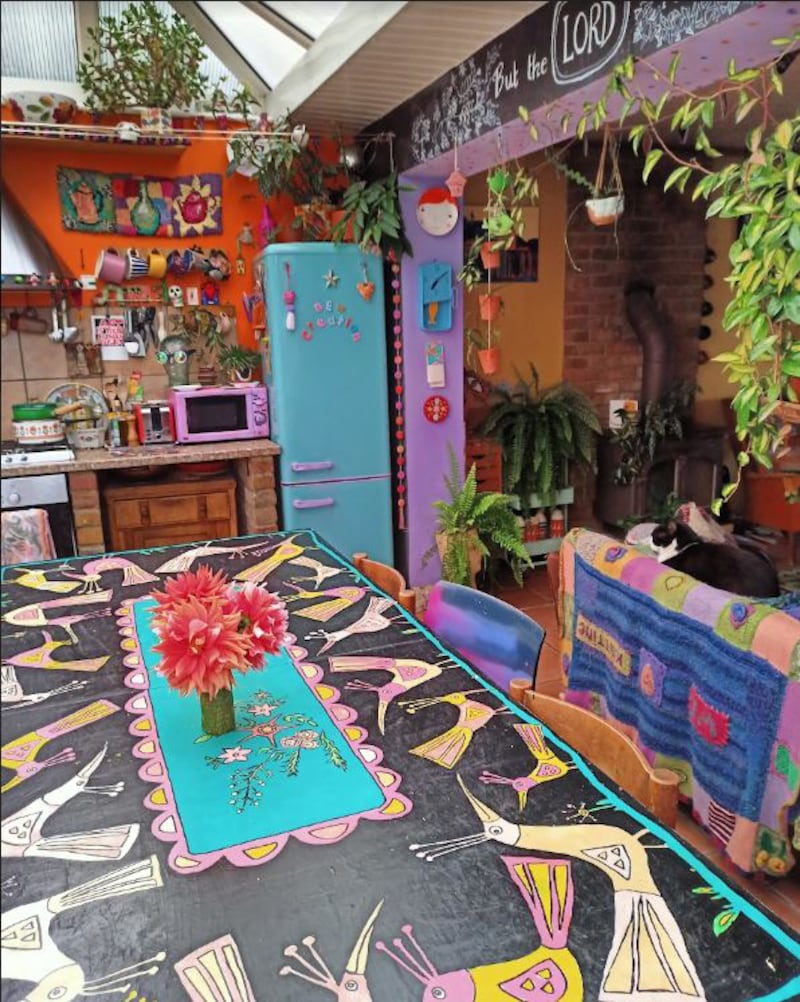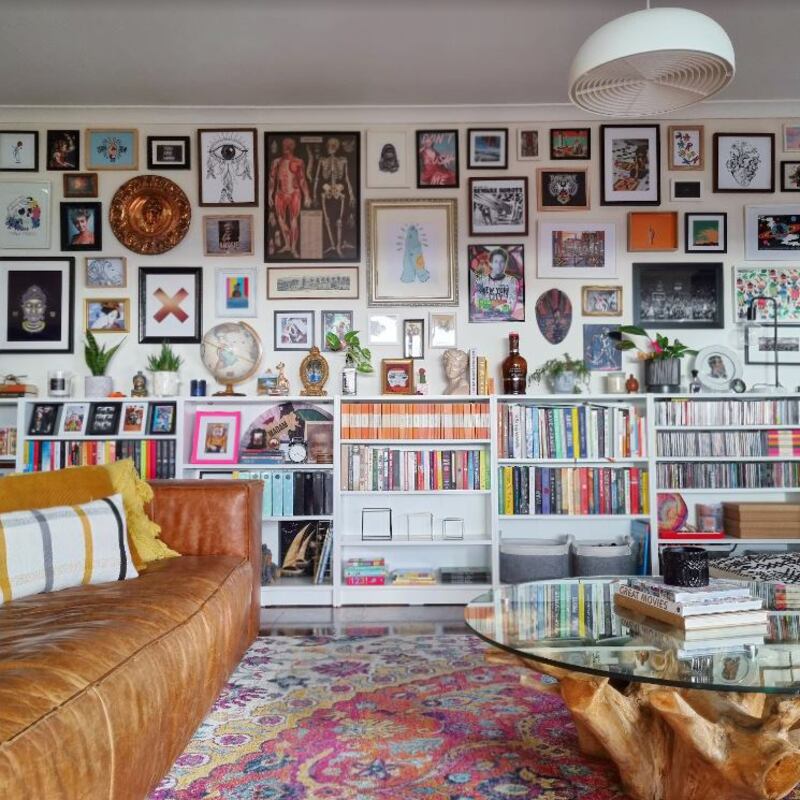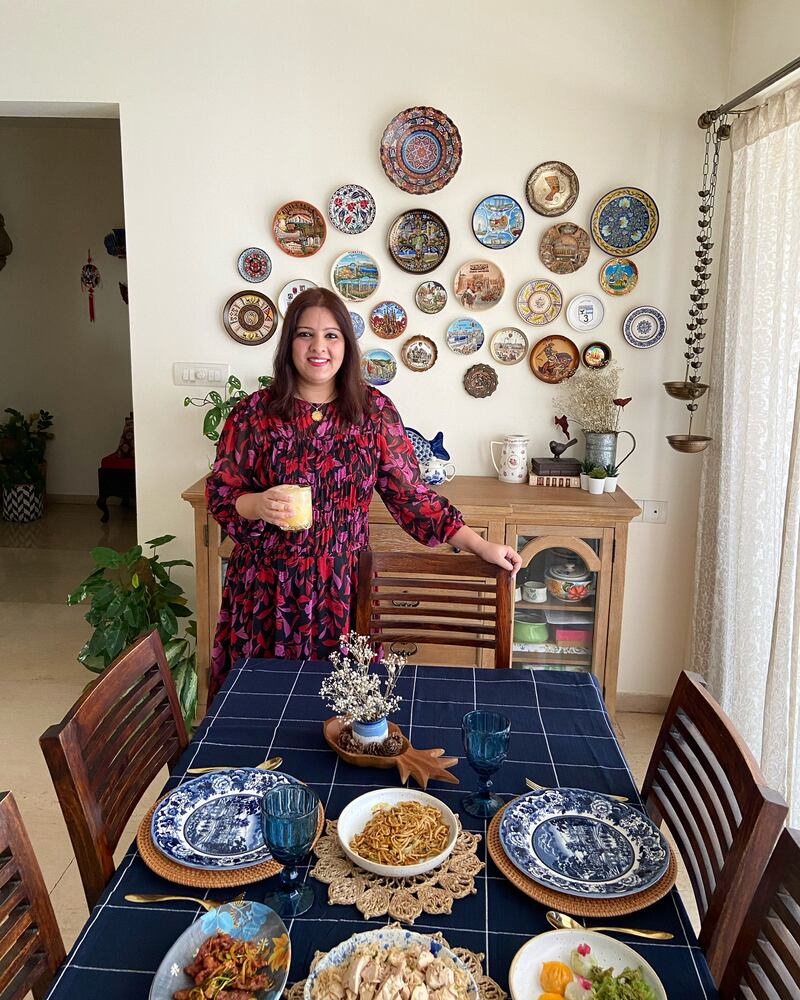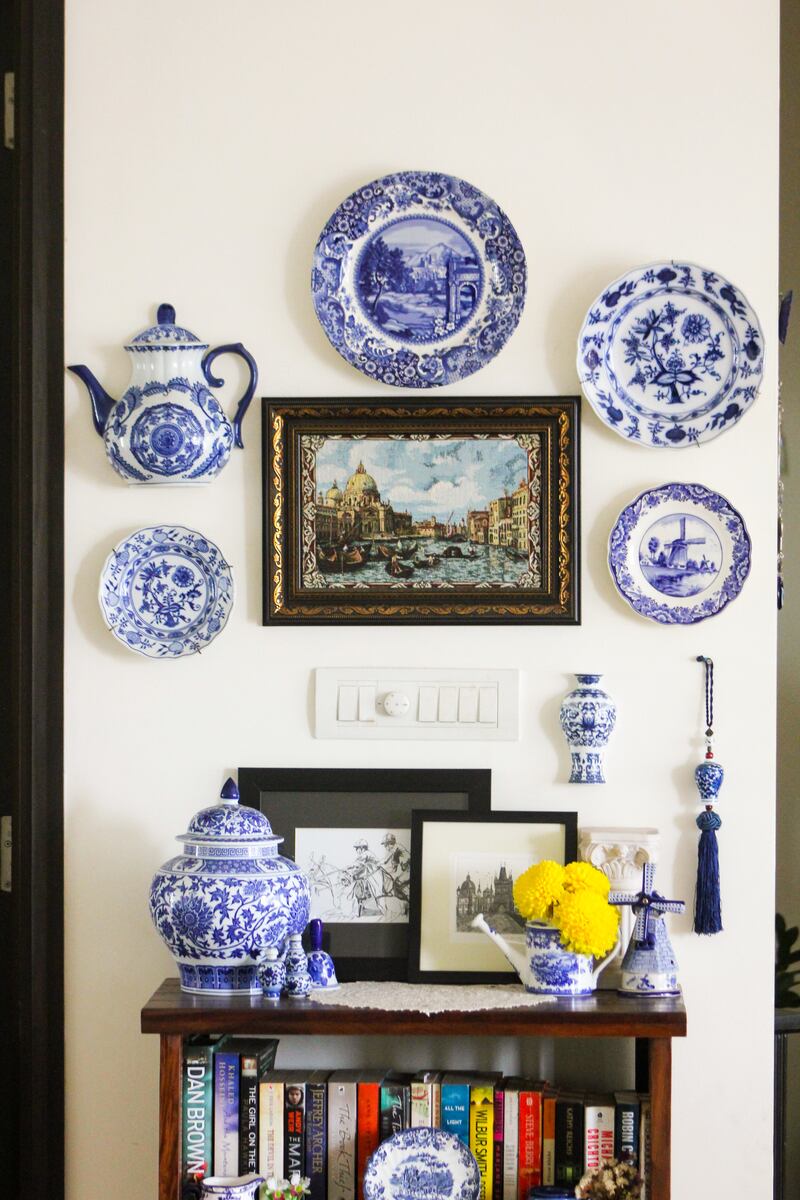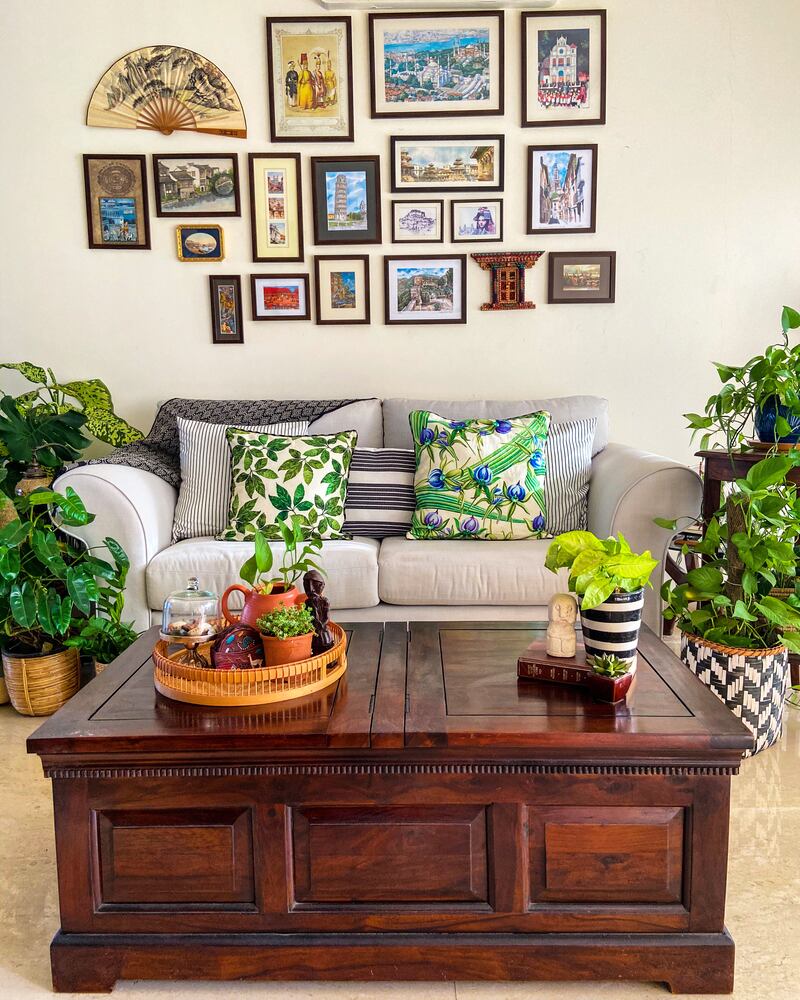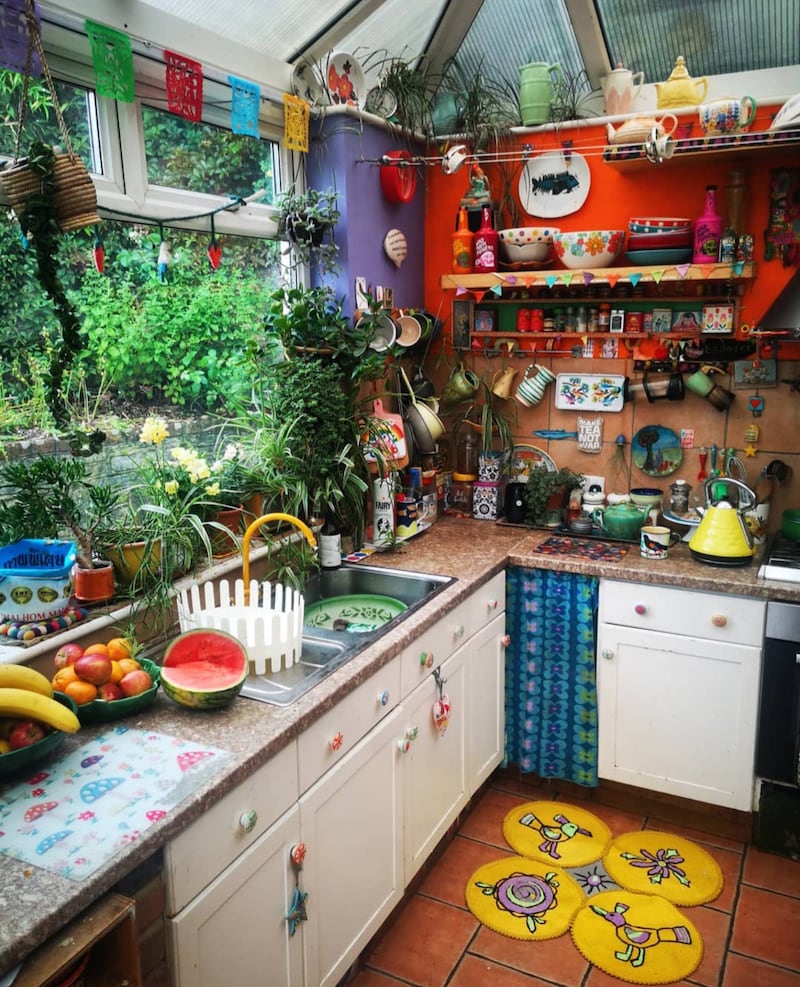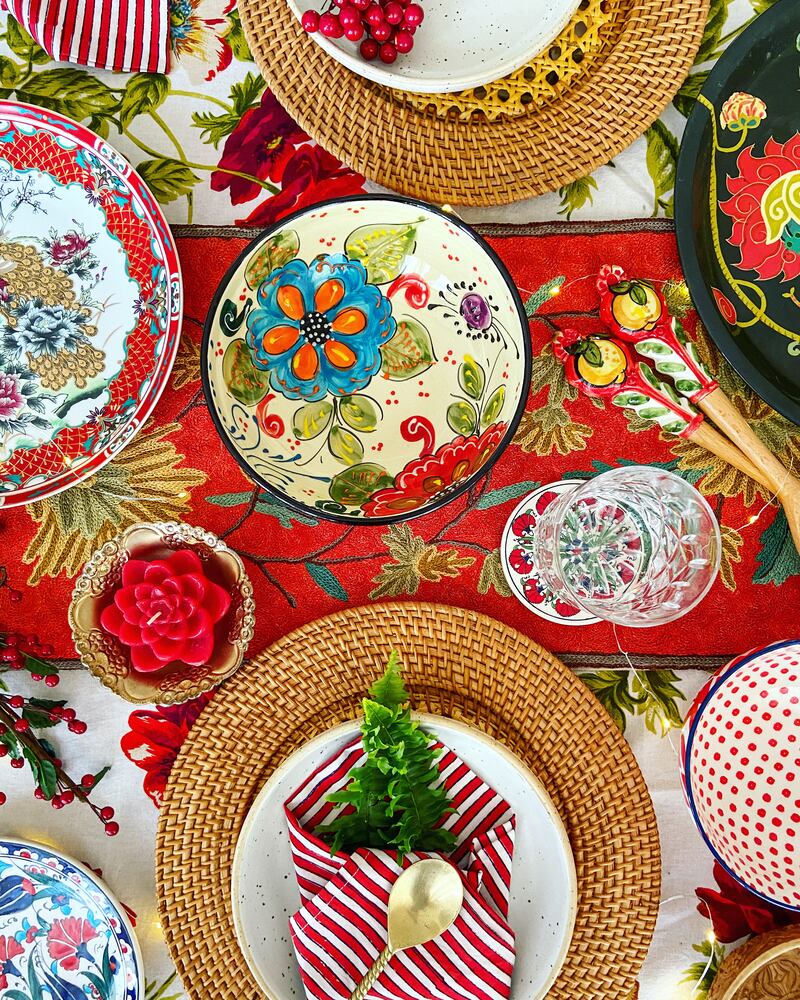Tangerine, hot pink and lemony yellow walls; mismatched cushions heaped on a plump sofa; framed pictures, knitted ornaments, wall art and painted plates; leafy tendrils cascading from bright hanging planters; hand-painted tables, trays and even a dishwasher; and vibrant mugs and pans strung and piled higgledy-piggledy around the kitchen. The visual effect of Kath Hitchings’s home is glorious, with its contrasting layers, colours, prints and fabrics exuding warmth and energy to showcase a well-lived-in-and-loved space.
Hitchings was all of 8 when she told her parents she wanted to be “garish”, even though she was not fully sure yet what the word meant. She continued to express her individuality over the years in colour through knitting, which she learnt at a young age, then on a professional level as an artist and art teacher, as well as in her vibrant home in Farnham, England.
“I’m a pastor’s wife and this is a community house with lots of visitors and lodgers. The kind of place where you don’t have to worry about jumping on the sofa,” says Hitchings.
What is cluttercore all about?
Her maximalist aesthetic of generous exuberance matches a recent design trend, echoed in thousands of photographs on social media as #cluttercore. Showcasing unapologetic abundance and individuality, this is excess in all its glory. But there is nothing messy or random about cluttercore. It is considered, deliberate and, as its advocates explain, a meaningful curation of stories and lives.
Reportedly coined by TikTok user @mDugy last year to describe an aesthetic of cosy and lived-in abundance, the term cluttercore gained momentum when more people realised it matched their own mismatched design philosophy.
This is an interior trend with no firm rules. “It is basically putting together in a room objects that are deeply personal, loved and have an emotional connect with the user,” says Ashish Vadehra, architect and studio head of LineArt in New Delhi, India. "It may not comply with a defined design aesthetic and that makes it quite unique."
Every home tells a story
It's like the dramatic gallery wall in the home of Paula Truscott, a marketing professional, and her partner Martin Loorits, a cabinetmaker, who live in Perth, Australia. Inspired by their love for art and books, the upper expanse is packed cheek-by-jowl with framed pictures.
A sketch of a pensive chimpanzee, Jerry Seinfeld outlined in neon colours, a calming Buddha and a black-and-white eye are just a few in the mix. Books, tchotchkes, potted plants and photographs swell the shelves below.
Elsewhere, a dining table is set with six different chairs; a bright yellow front door opens into a foyer with rich teal walls; and stripes, zig-zag patterns and triangles are worked into wallpaper around the house.
“A lot of people stick to the ‘rules’ inside their own homes. We like so many design styles and enjoy mixing old with new, so the eclectic route was the only way to go for us,” says Truscott.
Storytelling is intrinsic to cluttercore. “Each room in my house tells the story of who my husband and I are, and the places, events and experiences that have shaped us,” says copywriter Keerat Kaur who lives in Pune, India.
“The living room gallery wall has art collected from our travels. I also have a wall with souvenir wall plates, and a nook where I pay homage to my collection of blue and white ceramics, a love I inherited from my grandmother. And we have a nautical corner in a nod to my husband’s profession in the merchant navy and my experiences on the ship.”
What about minimalism?
While minimalism has been the dominant aesthetic for a while (we’re looking at you, Marie Kondo), cluttercore enthusiasts find it restrictive. “It doesn’t tell you about an individual’s personality. I gravitate towards art with plenty of details and points of interest. The eye should travel all over, pulled in different directions,” says Kaur.
Truscott prefers a mix. “I could never do minimalism 100 per cent, but I do enjoy calm in some spaces, like the laundry room, the kitchen and our bedroom,” she says. “Minimalism doesn't make sense in a living room where we enjoy family time. Sticking to minimalism is hard work, especially with kids.”
A crutch for hoarders?
To those out of the know, cluttercore is just a euphemism for hoarding, but supporters disagree. “Hoarding is an addictive tendency and is completely different," says Hitchings. "I am easy come, easy go with my things. This isn’t my treasure. This is my nest."
Truscott agrees. “Hoarding implies you're collecting items that are not useful and serve no purpose. In our case, all the items have a purpose, which is to make us happy.”
Many advocates are mindful of how they accumulate belongings, highlighting a significant benefit of cluttercore: sustainability. “Most of my possessions have been sourced from thrift shops, gifted, self-created or repurposed,” says Hitchings. “I believe in encouraging independent artists and I don’t mind spending on their creations.”
Truscott says: “We are avid thrift shoppers and believe that one man's trash is another man's treasure. I like to think we’re decorating in an environmentally friendly way.”
Creating gorgeous chaos
While appealing, it can be difficult to achieve cohesiveness with mismatched items. “There are a few [dos and don’ts] in the back of my mind, like decorating in triangles," says Truscott. "Or I wouldn’t put two tall things next to each other, for example. With the picture frames, we choose only black, white, wood and gold frames. There's enough colour in the artwork.”
Kaur recommends sticking to a common thread or theme, like colours. “I don’t have a complete dinner set, but an uncoordinated mix of ceramics from around the world with one thing in common – they’re blue and white.”
As cluttercore can be overwhelming and even high maintenance, Vadehra suggests a mix of styles. “Minimalism can be the primary layer, with little islands that incorporate things that are uniquely you and break the monotony of a straight-line aesthetic. Like an accent piece of furniture, a feature wall with framed family photos or a light fixture.”
But as with any trend, it is pointless to adopt cluttercore unless it truly resonates with you. “Be authentic," says Hitchings. "People want everything instantly now, but here is an aesthetic that actually is based on years of history and curation."
